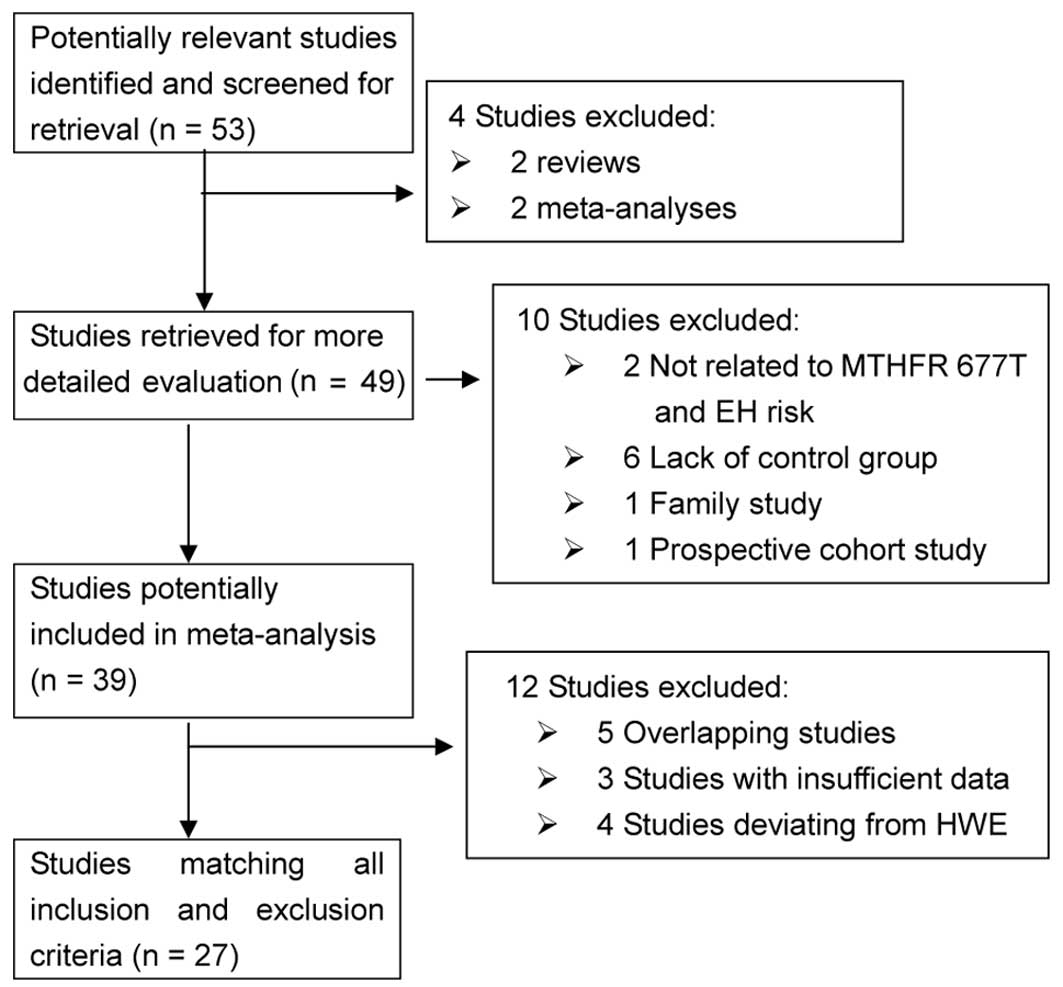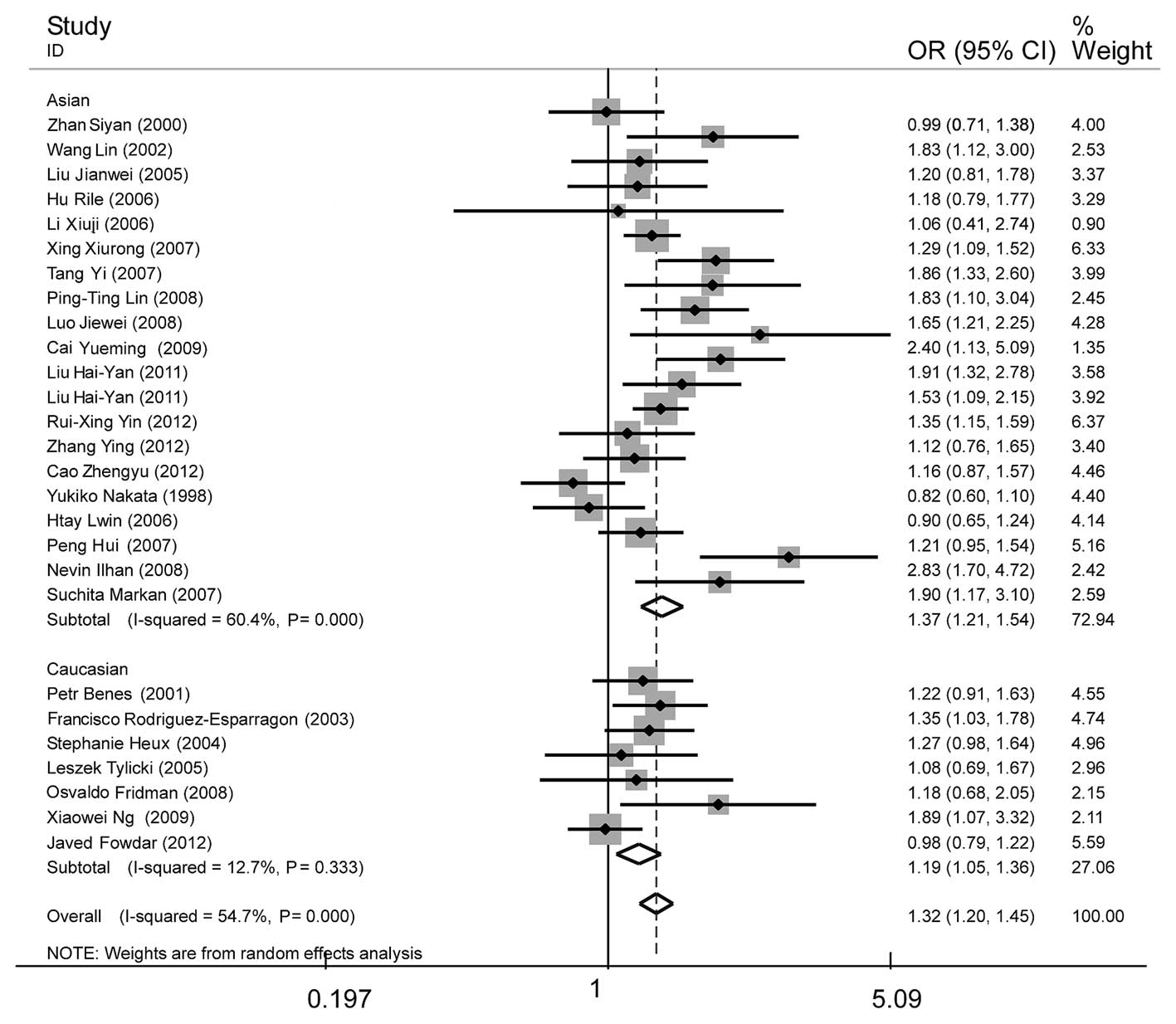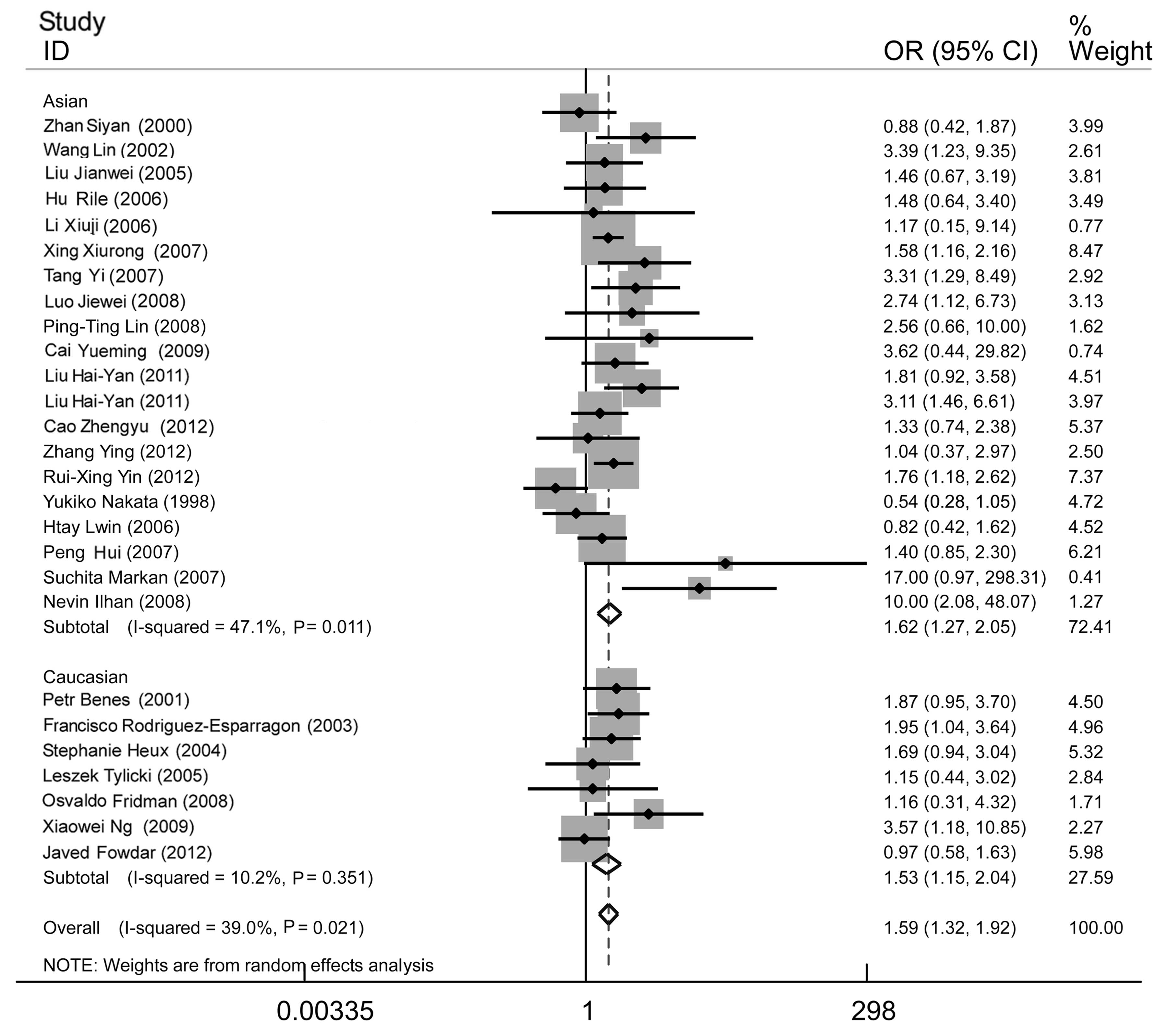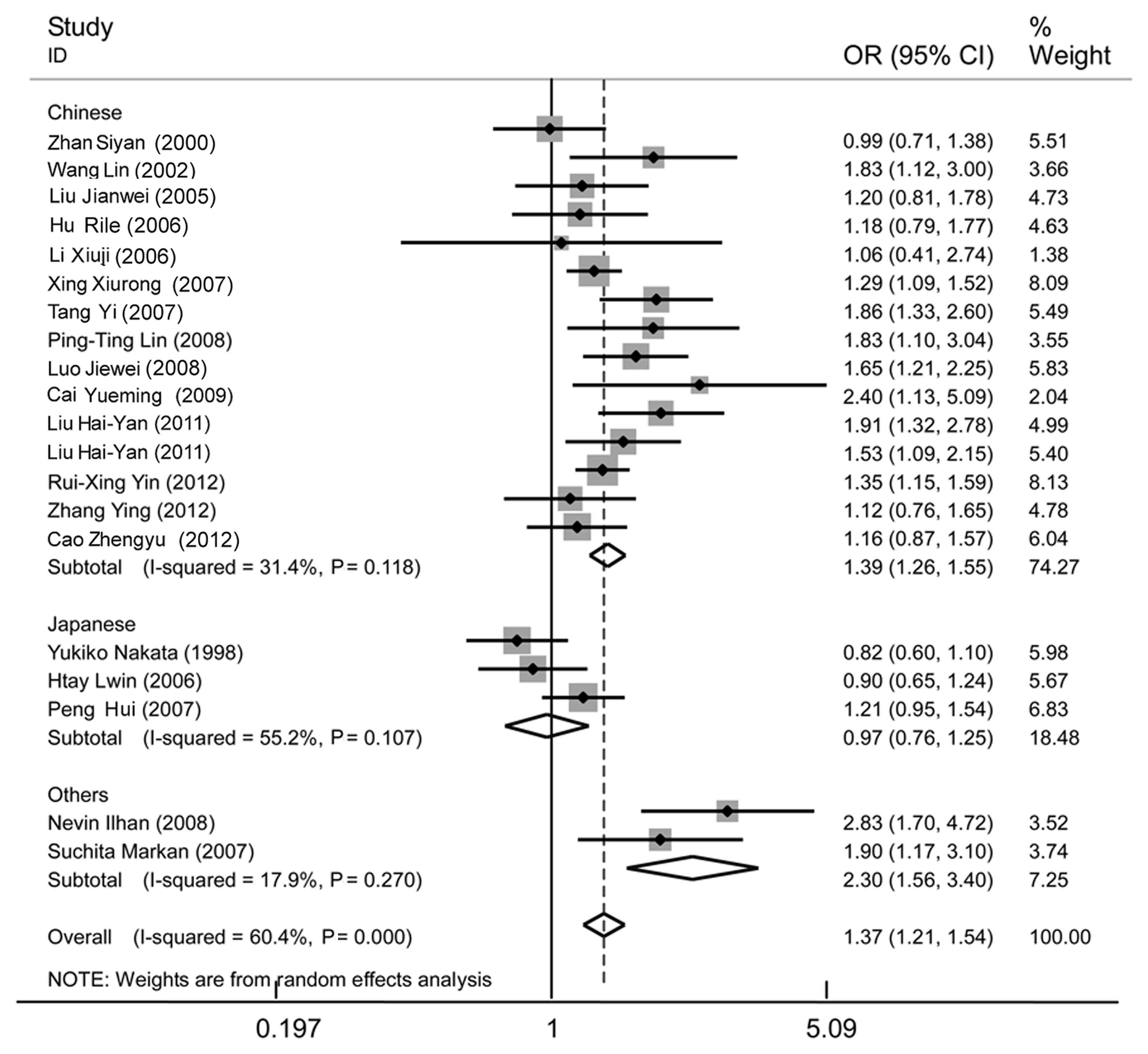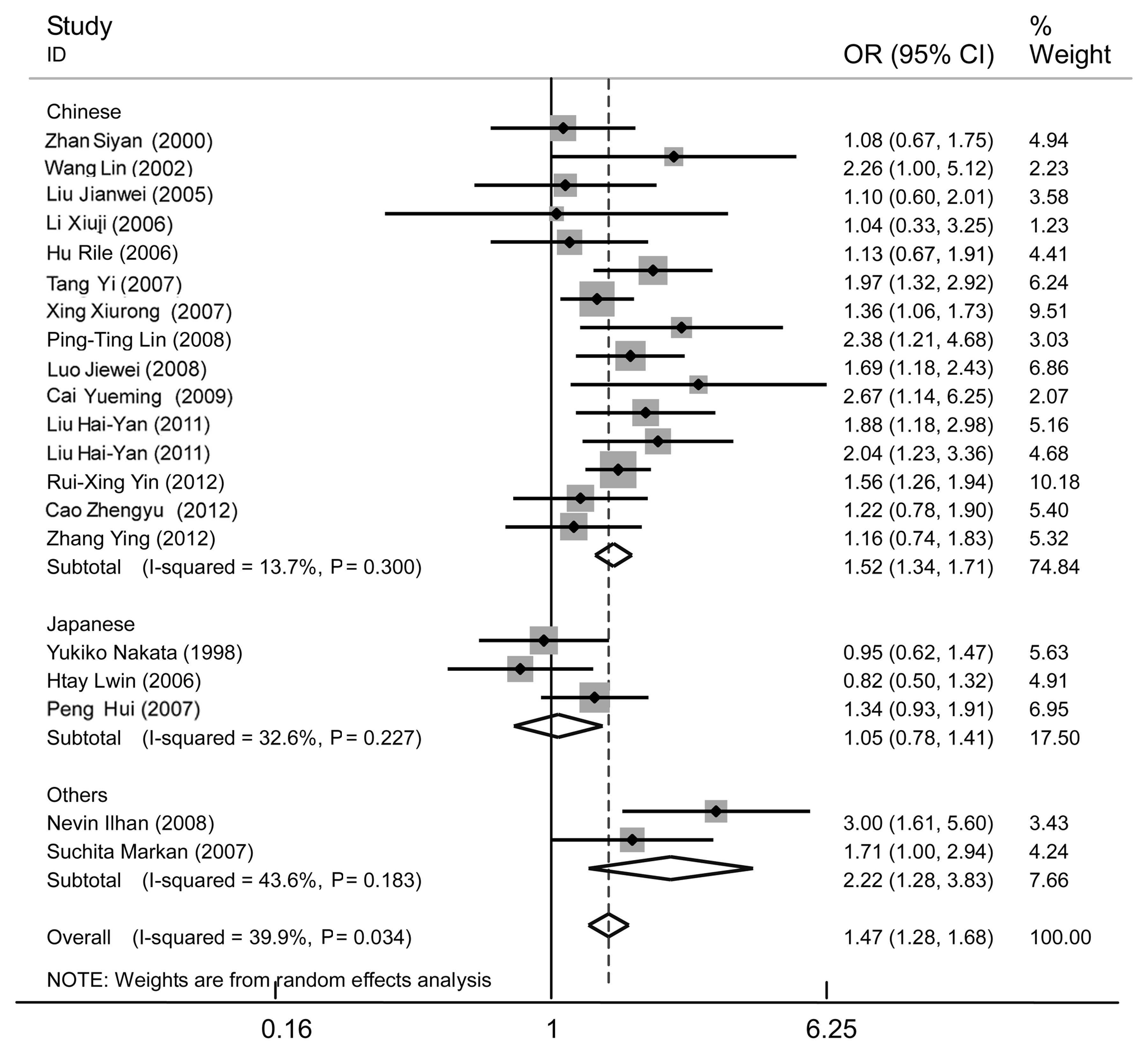Methylenetetrahydrofolate reductase C677T gene polymorphism and essential hypertension: A meta‑analysis of 10,415 subjects
- Authors:
- Published online on: June 25, 2014 https://doi.org/10.3892/br.2014.302
- Pages: 699-708
Abstract
Introduction
Essential hypertension (EH), as a polygenic disease with a high prevalence rate, is considered to develop from a complex interaction of diverse environmental conditions with multiple genetic factors in which the underlying genetic mechanism remains unknown (1,2).
A number of studies have been conducted to investigate the genetic components of EH. The genes involved in classical systems, including Renin-angiotensin-aldosterone system (RAAS), the central nervous system and the vascular-endothelial system, have been previously focused on (3,4) and the homocysteine (Hcy) pathway is an emerging target. The methylenetetrahydrofolate reductase (MTHFR) C677T mutation is one of the most common gene polymorphisms. Mapped to chromosomal region 1p36.3, the MTHFR gene spans a 2.2-kb length with 11 exons and 10 introns. The product, known as MTHFR, is a critical enzyme in Hcy metabolism (5). The C677C to T mutation in the catalyzing region of the MTHFR gene may induce the displacement of alanine by valine. This change may lead to the thermolability of the enzyme and the inhibition of MTHFR activity, thus decreasing the transformation from 5,10-methyltetrahydrofolate to 5-methyltetrahydrofolate, which acts as a co-substrate for the conversion from Hcy to methionine (6). The level of plasma Hcy, as a result, increases and may lead to certain pathological changes, including vascular endothelial injury, vascular smooth muscle proliferation and nitric oxide production inhibition (7), which may lead to the development of hypertension, as well as other diseases (8–11).
Studies on the MTHFR C677T gene polymorphism and EH association have been extensively performed previously, but the results obtained remain controversial. In 2003, a study conducted in Spain suggested that the MTHFR TT genotypes can predict the development of EH in males, and the association may be mediated by the elevation of the Hcy level (12). In 2008 and 2012, Lin et al (13) and Yin et al (14) investigated the association among the Chinese population in the Taichung and Guangxi areas, respectively, and the studies indicated that the MTHFR 677C to T genotypes may be significant risk factors for EH. However, in 2012, a case-control study regarding the association between four Hcy pathway gene variants, including MTHFR 677T and EH in Caucasians, indicated no significant association (15). More contrary results were found in a Japanese study by Nakata et al (16), which showed that the risk of hypertension significantly increased in subjects with the 677CC genotype, whereas the 677T gene polymorphism contributed to lower blood pressure.
Therefore, considering that the results of the studies carried out in the same ethnicity and different populations vary widely, the present meta-analysis of 10,415 subjects was conducted from 27 eligible studies to obtain a comprehensive conclusion on this association. The study demonstrated the association between the MTHFR C677T gene polymorphism and EH in the whole population. The association in different subgroup populations with reasonable clarification of the heterogeneity was shown clearly.
Materials and methods
Publication search and inclusion criteria
Electronic databases, including PubMed, Web of Science, China National Knowledge Infrastructure, WanFang and WeiPu were searched for relevant studies written in English or Chinese using the keywords: ‘Methylenetetrahydrofolate reductase or MTHFR’, ‘polymorphism’ and ‘hypertension’ (the last search was updated on April 1, 2013). Included studies were required to meet the following major criteria: i) Case-control or cross-sectional studies investigating the association between the MTHFR C677T polymorphism and EH; ii) present genotype counts of the patient and control groups; iii) diagnosis of EH patients based on the criteria of systolic blood pressure ≥140 mmHg or diastolic blood pressure ≥90 mmHg. Secondary hypertension was excluded; and (iv) for overlapping studies, the studies with the larger sample size were included.
Data extraction
The following data from each eligible study were independently extracted in duplicate by two investigators: First author’s name, publication year, population origin, genotype counts of cases and controls, study design, sample size, genotyping method, male percentage and age of patients and controls. The two extractions were compared and any discrepancy was resolved through discussion until a consensus was reached.
Statistical analysis
In the current meta-analysis, the association between the MTHFR C677T gene polymorphism and EH was revealed and analyzed by the odds ratio (OR) corresponding to the 95% confidence interval (CI) between cases and controls under five genetic models, which were the allelic (T/C), dominant (TT + CT/CC), recessive (TT/CT + CC), homozygote (TT/CC) and heterozygote models (CT/CC).
Between-study heterogeneity was estimated by χ2-based Q analysis, and significance was set at P<0.05. The variation caused by heterogeneity was also evaluated by the inconsistency index, I2 (I2=0–25%, no heterogeneity; 25–50%, moderate; 50–75%, large; and 75–100%, extreme heterogeneity). The DerSimonian and Laird random-effects model was applied whether or not heterogeneity among studies was observed. The Z test was used to determine the pooled OR, and significance was set at P<0.05. In addition, to examine the degree to which an individual study affects the overall estimate, sensitivity analyses were conducted by removing one study at a time and analyzing the change of the pooled effect. To explore the potential sources of heterogeneity, a random-effects meta-regression was performed. Additionally, subgroup analyses were implemented subsequent to stratifying the included studies according to population origin and study design.
Fisher’s exact test was used to assess the Hardy-Weinberg equilibrium (HWE). Potential publication bias was estimated by Begg’s funnel plot together with Egger’s linear regression test. Statistical analysis was performed using STATA 11.0 (StataCorp, College Station, TX, USA).
Results
Search results and study characteristics
A total of 53 potentially relevant papers were obtained by the literature search, of which 27 met the inclusion criteria (8,12–37). Of the 26 excluded studies, four studies were reviews or meta-analyses, five were overlapping studies, six lacked controls groups, three did not provide genotype counts, two were unrelated to MTHFR C677T and the EH risk and four studies deviated from the HWE. One family study and one prospective cohort study were also excluded (Fig. 1). The present meta-analysis involved 5,418 EH patients and 4,997 controls of Asian (Chinese, Japanese, Indian and Turks) and Caucasian (Australian, South Welsh, Argentinean, Austrian, Polish, Spanish and Czech) origin. Specifically, 6,188 subjects of 15 studies were Chinese from various parts of China, including Beijing, Tianjin, Shanghai, Fujian, Shenzhen, Yunnan, Ningxia, Guangxi, Mongolia, Xinjiang and Taiwan (Table I).
Table ICharacteristics of 27 included studies of the association between the methylenetetrahydrofolate reductase C677T gene polymorphism and essential hypertension (EH). |
Pooled effect under different genetic models
Among the 27 included studies, 14 separate studies showed a significant association between the MTHFR 677T gene polymorphism and EH risk (8,12–14,17–26), whereas the remaining 13 studies did not (15,16,27–37). Through meta-analysis, a significant association was revealed between the MTHFR 677T gene polymorphism and EH under the allelic (OR, 1.32; 95% CI, 1.20–1.45; P=0.000), dominant (OR, 1.39; 95% CI, 1.25–1.55; P=0.000), recessive (OR, 1.38; 95% CI, 1.18–1.62; P=0.000), homozygote (OR, 1.59; 95% CI, 1.32–1.92; P=0.000), and heterozygote (OR, 1.32; 95% CI, 1.20–1.45; P=0.000) genetic models (Figs. 2–5 and Table II). The overall pooled effect remained almost unchanged following the sensitivity analysis, which indicated the robustness of the results in the meta-analysis.
Table IISummary of the meta-analysis results of the association between the MTHFR C677T gene polymorphism and essential hypertension under the different genetic models. |
A subsequent subgroup analysis stratified by ethnicity was conducted in which a significant association between the MTHFR C677T gene polymorphism and EH was revealed in the Asian and Caucasian subgroups. The association was evident in all genetic models in the Asian subgroup (allelic: OR, 1.37; 95% CI, 1.21–1.54; P=0.000; dominant: OR, 1.47; 95% CI, 1.28–1.68; P=0.000; recessive: OR, 1.37; 95% CI, 1.12–1.68; P=0.002; homozygote: OR, 1.62; 95% CI, 1.27–2.05; P=0.000; and heterozygote: OR, 1.40; 95% CI, 1.25–1.56; P=0.000), whereas in the Caucasian subgroup an association was apparent under all models, except the heterozygote model (allelic: OR, 1.19; 95% CI, 1.05–1.36; P=0.007; dominant: OR, 1.19; 95% CI, 1.02–1.40; P=0.031; recessive OR, 1.42; 95% CI, 1.10–1.84; P=0.008; homozygote: OR, 1.53; 95% CI, 1.15–2.04; P=0.004; and heterozygote: OR, 1.13; 95% CI, 0.96–1.34; P=0.152). The association detected in the Asian group was stronger compared to the Caucasian group under all genetic models, with the exception of the recessive model (Figs. 2–5 and Table II).
Heterogeneity analysis
The heterogeneity test was significant under the allelic (I2=54.7%, P=0.000), dominant (I2=35.6%, P=0.036) and homozygote (I2=39%, P=0.021) models. Following the subgroup analysis, there was no significant heterogeneity observed in the Caucasian subgroup, whereas it remained apparent in the Asian subgroup (Figs. 2–5 and Table II). A further subgroup analysis in the Asian group was considered by stratification of Chinese, Japanese and others (Indian and Turk). Heterogeneity was not evident in any subgroup under the different genetic models, indicating that population origin may be one explanation for the between-study heterogeneity (Figs. 6–7 and Table III).
Table IIISummary of the subgroup analysis results under different genetic models in different Asian populations. |
The further subgroup analysis also revealed a strong association between the MTHFR C677T gene polymorphism and EH in the Chinese population (allelic: OR, 1.39; 95% CI, 1.26–1.55; P=0.000; dominant: OR, 1.52; 95% CI, 1.34–1.71; P=0.000; recessive: OR, 1.45; 95% CI, 1.24–1.70; P=0.000; and homozygote: OR, 1.71; 95% CI, 1.44–2.03; P=0.000). None of these genetic models suggested any association between MTHFR 677T and EH among the Japanese population (Figs. 6–7 and Table III).
In addition, to explore other potential sources of heterogeneity, a random-effects meta-regression analysis including all 27 studies was conducted under the allelic, dominant and homozygote models. The publication year, population origin (Chinese as 1; Japanese as 2; other Asian, including Indian and Turk, as 3; and Caucasian as 4), case sample size, control sample size, total sample size, the ratio of case and control sample, the percentage of males, age of cases and controls, study design [hospital-based (HB) as 1 and population-based (PB) as 2] and genotyping method [polymerase chain reaction (PCR)-restriction fragment length polymorphism as 1; others, including Sequenom and real-time fluorescence quantitative-PCR, as 2] were considered as independent variables. In contrast to the subgroup analysis, no association of population origin was observed under any genetic model. However, a significant and marginal association of study design was revealed under the dominant (P=0.035) and allelic genetic models (P=0.068), respectively. Therefore, another stratified analysis was conducted by organizing studies into HB or PB studies under the dominant and allelic genetic models. There was no significant heterogeneity in the PB subgroup under the genetic models (Table IV), whereas the HB subgroup yielded a significance under the allelic genetic model indicating that study design may play a role in heterogeneity. Additionally, an association between the MTHFR C677T gene polymorphism and EH was found to be stronger in the HB studies compared to the PB studies.
Table IVSummary of the subgroup analysis results of all included studies stratified by study design. |
Publication bias
Publication bias was assessed by Begg’s funnel plot and Egger’s test. The visible symmetrical funnel shape indicated no apparent evidence of publication bias in the meta-analysis, which is in accordance with the results of Egger’s test (allelic: P=0.122; dominant: P=0.378, recessive: P=0.078, homozygote: P=0.104; and heterozygote genetic model: P=0.550). There was no significant difference revealed, which suggests a low probability of publication bias (Fig. 8).
Discussion
Meta-analysis is an efficient method to obtain a pooled effect of various studies with relatively small sample sizes and to achieve more comprehensive conclusions. Several meta-analyses that have been conducted in our Department of Geriatrics (First Affiliated Hospital of Nanjing Medical University, Nanjing, China) recently provided reliable results for the association between different gene polymorphisms and cardiovascular diseases (38,39). The present meta-analysis, which involved 5,418 cases and 4,997 controls from 27 studies carried out worldwide, indicated a strong association between the MTHFR C677T gene polymorphism and EH in the whole population under the allelic (OR, 1.32; 95% CI, 1.20–1.45; P=0.000), dominant (OR, 1.39; 95% CI, 1.25–1.55; P=0.000), recessive (OR, 1.38; 95% CI, 1.18–1.62; P=0.000), homozygote (OR, 1.59; 95% CI, 1.32–1.92, P=0.000), and heterozygote (OR, 1.32; 95% CI, 1.20–1.45; P=0.000) genetic models.
A significant association was detected in the Asian and Caucasian groups (P<0.05) suggesting that carriers of 677T or 677TT in these populations may suffer a significantly increased risk of developing EH. In the further subgroup analysis of the Asian population, stratified as Chinese, Japanese and others (Indian, Turk), the significant heterogeneity no longer existed in any subgroup suggesting that the population origin may contribute to heterogeneity. Future studies should pay increasing attention to the possible differences in genetic background of various populations. In addition, the pooled analysis of 6,188 Chinese subjects from 15 studies showed a strong association between the MTHFR C677T gene polymorphism and EH, revealing that it was a possible risk factor for EH in the Chinese population. There was no apparent association between the MTHFR C677T gene polymorphism and EH among the Japanese population. Considering that only three studies were included in the subgroup, a meta-analysis including more Japanese studies and future studies with larger samples could be conducted to confirm this result. Additionally, the study design was identified as an explanation for between-study heterogeneity in the meta-regression analysis, as well as the subgroup analysis. A stronger association together with greater heterogeneity was observed in HB studies compared to PB studies. This difference may be explained by the fact that control subjects from hospitals tend to have more complicated health states and confounding factors, whereas the controls selected from the general population would be more representative. The poor comparability between patients and controls in HB studies may contribute to the heterogeneity and exaggerate the association of the MTHFR 677T gene polymorphism and EH to a certain degree (40).
Two meta-analyses, by Qian et al (41) and Niu et al (42), were conducted previously in the whole population and in the Chinese population, respectively. Compared to these studies, the present meta-analysis had substantial advantages in the following aspects: First, only nine studies with 1,520 patients and 1,334 controls in the study by Niu et al (42) and 12 out of 25 studies in the study by Qian et al (41) were studies regarding the association between the MTHFR C677T gene polymorphism and EH. The remaining studies in the two meta-analyses assessed hypertension in pregnancy (HIP). Considering the multiple pathogenesis and complicated physiopathological changes in HIP cases, it is not suitable to analyze the pooled effect of the association between the MTHFR C677T gene polymorphism and hypertension with HIP patients. Therefore, with an increase of 18 studies from the latest meta-analysis regarding the association between MTHFR C677T and EH (42), the present study assessed 27 eligible studies with a total of 5,418 EH cases and 4,997 controls. This provides more reliable results with less clinical heterogeneity. One overlapping study and particular studies of secondary hypertension, which were included previously, were excluded. Second, compared to the unexplained heterogeneity of the Asian subgroup in the Qian et al (41) study, the heterogeneity of the Asian population no longer existed in the Chinese, Japanese and other (Indian and Turk) subgroups following stratified analysis in the present study. This suggested that the population origin may be one reason for heterogeneity. Third, in terms of meta-regression, while only a marginal association (P=0.082) of study design was observed in the Niu et al (42) study, the association in the present study was significant (P=0.035). This may be due to the relatively few included studies in the study by Niu et al, and studies involved in meta-regression should usually be ≥10 (43). Therefore, with stronger evidence, the present meta-analysis demonstrated the effect of study design in heterogeneity. Finally, the present meta-analysis involved a wide range of various populations and the pooled effect of 15 Chinese studies with 3,420 cases and 2,768 controls was also revealed in the subgroup analysis. For this reason, the study renewed the two previous meta-analyses with additional supplements and appropriate adjustments, and thus, to the best of our knowledge, becoming the most comprehensive meta-analysis regarding the association between MTHFR C677T and EH.
The present meta-analysis, although notably having advantages, such as large sample sizes, reliable statistical results and sound heterogeneity management, has certain limitations. First, large-scale studies on the association between the MTHFR gene polymorphism and EH are inadequate. Second, as discussed previously, the MTHFR C677T gene mutation is postulated to play a role in developing EH through generating hyperhomocysteinemia. However, the level of plasma Hcy is also influenced by certain environmental factors, including lack of folate and vitamin B6 in the diet, and is associated with plasma folate levels (8,26). The interaction between gene and environment was not taken into account. Therefore, future prospective cohort studies with large sample sizes should be performed to confirm these results and studies should include these considerations.
In conclusion, the present meta-analysis, including 27 studies with 10,415 subjects, indicates that the MTHFR C677T gene polymorphism is associated with increased EH risks in different populations as a whole, as well as in separate subgroups, such as Asian, Caucasian and Chinese. Carriers of the 677T allele are susceptible to EH. MTHFR C677T should therefore be tested for as a predictive screening for the identification of the individuals that may develop EH in the future. As an improvement on the previous studies with noteworthy reinforcement and development, the present results may potentially provide a stronger foundation for the identification of the mechanism through which the MTHFR gene may play a role in developing EH. More studies should be conducted to confirm the conclusion, and polymorphisms within the same linkage disequilibrium area should be focused on as well.
Acknowledgements
The authors would like to thank all the subjects participating in the present study. The study was supported by the ‘six elite peaks’ project, funded by the Jiangsu Province Government, China (grant no. 2008-329).
References
|
Mein CA, Caulfield MJ, Dobson RJ and Munroe PB: Genetics of essential hypertension. Hum Mol Genet. 13:R169–R175. 2004. View Article : Google Scholar : PubMed/NCBI | |
|
Dominiczak AF, Negrin DC, Clark JS, Brosnan MJ, McBride MW and Alexander MY: Genes and hypertension: from gene mapping in experimental models to vascular gene transfer strategies. Hypertension. 35:164–172. 2000. View Article : Google Scholar : PubMed/NCBI | |
|
Lupton SJ, Chiu CL and Lind JM: A hypertension gene: are we there yet? Twin Res Hum Genet. 14:295–304. 2011. View Article : Google Scholar : PubMed/NCBI | |
|
Men C, Tang K, Lin G, Li J and Zhan Y: ENOS-G894T polymorphism is a risk factor for essential hypertension in China. Indian J Biochem Bio. 48:154–157. 2011.PubMed/NCBI | |
|
Goyette P, Pai A, Milos R, et al: Gene structure of human and mouse methylenetetrahydrofolate reductase (MTHFR). Mamm Genome. 9:652–656. 1998. View Article : Google Scholar | |
|
Frosst P, Blom HJ, Milos R, et al: A candidate genetic risk factor for vascular disease: a common mutation in methylenetetrahydrofolate reductase. Nat Genet. 10:111–113. 1995. View Article : Google Scholar : PubMed/NCBI | |
|
Tawakol A, Omland T, Gerhard M, Wu JT and Creager MA: Hyperhomocyst(e)inemia is associated with impaired endothelium-dependent vasodilation in humans. Circulation. 95:1119–1121. 1997. View Article : Google Scholar : PubMed/NCBI | |
|
Heux S, Morin F, Lea RA, Ovcaric M, Tajouri L and Griffiths LR: The methylentetrahydrofolate reductase gene variant (C677T) as a risk factor for essential hypertension in Caucasians. Hypertens Res. 27:663–667. 2004. View Article : Google Scholar : PubMed/NCBI | |
|
Li YY: Methylenetetrahydrofolate reductase C677T gene polymorphism and coronary artery disease in a Chinese Han population:a meta-analysis. Metabolism. 61:846–852. 2012. View Article : Google Scholar : PubMed/NCBI | |
|
Alam MA, Husain SA, Narang R, Chauhan SS, Kabra M and Vasisht S: Association of polymorphism in the thermolabile 5, 10-methylene tetrahydrofolate reductase gene and hyperhomocysteinemia with coronary artery disease. Mol Cell Biochem. 310:111–117. 2008. View Article : Google Scholar : PubMed/NCBI | |
|
Homocysteine Studies Collaboration. Homocysteine and risk of ischemic heart disease and stroke: a meta-analysis. JAMA. 288:2015–2022. 2002. View Article : Google Scholar : PubMed/NCBI | |
|
Rodríguez-Esparragón F, Hernández-Perera O, Rodríguez- Pérez J, et al: The effect of methylenetetrahydrofolate reductase C677T common variant on hypertensive risk is not solely explained by increased plasma homocysteine values. Clin Exp Hypertens. 25:209–220. 2003.PubMed/NCBI | |
|
Lin PT, Cheng CH, Wei JC and Huang YC: Low plasma pyridoxal 5′-phosphate concentration and MTHFR 677C-->T genotypes are associated with increased risk of hypertension. Int J Vitam Nutr Res. 78:33–40. 2008. | |
|
Yin RX, Wu JZ, Liu WY, et al: Association of several lipid-related gene polymorphisms and blood pressure variation in the Bai Ku Yao population. Am J Hypertens. 25:927–936. 2012. View Article : Google Scholar : PubMed/NCBI | |
|
Fowdar JY, Lason MV, Szvetko AL, Lea RA and Griffiths LR: Investigation of homocysteine-pathway-related variants in essential hypertension. Int J Hypertens. 2012:1909.232012.PubMed/NCBI | |
|
Nakata Y, Katsuya T, Takami S, et al: Methylenetetrahydrofolate reductase gene polymorphism relation to blood pressure and cerebrovascular disease. Am J Hypertens. 11:1019–1023. 1998. View Article : Google Scholar : PubMed/NCBI | |
|
Liu HY, Ma P and Xu QB: The correlation between polymorphisms of N5,10 methylenetetrahydrofolate reductase and essential hypertension in Han population in Ningxia. Guangdong Med J. 32:1977–1980. 2011. | |
|
Liu H, Chen S, Ma P and Xu Q: The association between gene polymorphisms of N5,10-methylenetetrahydrofolate reductase and essential hypertension in patients of Ningxia Hui nationality. Tianjin Med J. 39:1095–1098. 2011. | |
|
Cai YM and Gong WX: Linkage study on methylenetetrahydrofolate reductase single nucleotide polymorphisms and hypertension in the elderly with rheumatoid arthritis. Chin J Birth Health and Heredity. 17:14–17. 2009. | |
|
Luo JW, Tang Y, Chen H, Wu XY, Wu YN and Deng YL: Study on MTHFR C677T polymorphism in hypertensive subjects with blood stasis syndrome. J Beijing Univ Tradit Chin Med. 31:351–354. 2008. | |
|
Xing X and Hua Q: Relationships between the polymorphism of methylenetetrahydrofolate reductase gene C677T and hypertension, cardiac structure and function. Med J Chin PLA. 32:741–744. 2007. | |
|
Tang Y, Chen H, Wu XY and Luo JW: The C677T point mutation of N5,10-methylenetetrahydrofolate reductase (MTHFR) and essential hypertension. Mol Cardiol China. 7:205–207. 2007. | |
|
Wang L, Guo H and Li Y: MTHFR gene C 677 T polymorphisms and variation of plasma homocysteine level in primary hypertension. Tianjin Med J. 30:579–582. 2002. | |
|
Ilhan N, Kucuksu M, Kaman D, Ilhan N and Ozbay Y: The 677 C/T MTHFR polymorphism is associated with essential hypertension, coronary artery disease, and higher homocysteine levels. Arch Med Res. 39:125–130. 2008. View Article : Google Scholar : PubMed/NCBI | |
|
Markan S, Sachdeva M, Sehrawat BS, Kumari S, Jain S and Khullar M: MTHFR 677 CT/MTHFR 1298 CC genotypes are associated with increased risk of hypertension in Indians. Mol Cell Biochem. 302:125–131. 2007. View Article : Google Scholar : PubMed/NCBI | |
|
Ng X, Boyd L, Dufficy L, et al: Folate nutritional genetics and risk for hypertension in an elderly population sample. J Nutrigenet Nutrigenomics. 2:1–8. 2009. View Article : Google Scholar : PubMed/NCBI | |
|
Fridman O, Porcile R, Vanasco V, Junco MN, Gariglio L, et al: Study on homocysteine levels and methylenetetrahydrofolate reductase gene variant (C677T) in a population of Buenos Aires City. Clin Exp Hypertens. 30:574–584. 2008. View Article : Google Scholar : PubMed/NCBI | |
|
Zhan S, Gao YY, Yin X, et al: Elevated serum homocysteine, MTHFR gene mutataion and essential hypertension in Chinese. Chin J Hypertens. 8:21–25. 2000. | |
|
Lwin H, Yokoyama T, Yoshiike N, et al: Polymorphism of methylenetetrahydrofolate reductase gene (C677T MTHFR) is not a confounding factor of the relationship between serum uric acid level and the prevalence of hypertension in Japanese men. Circ J. 70:83–87. 2006. View Article : Google Scholar : PubMed/NCBI | |
|
Zhang Y, Wang H, Zhang X, Wang L and Wu G: Relationship between homocysteine, methylene tetrahydrofolate reductase C677T polymorphisms and essential hypertension in Kazak nationality in Xinjiang. J Clin Cardiol (China). 28:570–573. 2012. | |
|
Cao Z: The Association between methylenetetrahydrofolate reductase gene polymorphism and hypertensive elderly patient with acute myocardial infarction. Chin J Gerontol. 32:5118–5120. 2012. | |
|
Li X and Huang W: The analysis of MTHFR gene polymorphism in patients with renal damage caused by hypertension and patients with renal parenchymal hypertension. J Capital Univ Med Sci. 27:497–500. 2006. | |
|
Hu R, Niu GM, Zhao SG, Zhang CY, Hu RL, Wang ZG and Jiang MF: The association between gene polymorphisms of N5, 10-methylenetetrahydrofolate reductase and Mongolian patients with drimary hypertension. Chin J Hypertension. 14:274–276. 2006. | |
|
Liu JW, Ye L, Liu J and Li XY: Study on homocysteine metabolism-related enzymes gene polymorphisms in elderly essential hypertension patients with peripheral arterial occlusive disease. Chin J Geriatr. 24:332–335. 2005. | |
|
Hui P, Nakayama T, Morita A, et al: Common single nucleotide polymorphisms in Japanese patients with essential hypertension: aldehyde dehydrogenase 2 gene as a risk factor independent of alcohol consumption. Hypertens Res. 30:585–591. 2007. View Article : Google Scholar | |
|
Tylicki L, Födinger M, Puttinger H, et al: Methylenetetrahydrofolate reductase gene polymorphisms in essential hypertension. Am J Hypertens. 18:1442–1448. 2005. View Article : Google Scholar : PubMed/NCBI | |
|
Benes P, Kanková K, Muzík J, Groch L and Benedik J: Methylenetetrahydrofolate reductase polymorphism, type II diabetes mellitus, coronary artery disease, and essential hypertension in the Czech population. Mol Genet Metab. 73:188–195. 2001. View Article : Google Scholar | |
|
Li YY: α-Adducin Gly460Trp gene mutation and essential hypertension in a Chinese population: a meta-analysis including 10,960 subjects. PLoS One. 7:e302142012. | |
|
Li Y: Plasminogen activator inhibitor-1 4G/5G gene polymorphism and coronary artery disease in the Chinese Han population: a meta-analysis. PLoS One. 7:e335112012. View Article : Google Scholar : PubMed/NCBI | |
|
Ruano-Ravina A, Pérez-Ríos M and Barros-Dios JM: Population-based versus hospital-based controls: are they comparable? Gac Sanit. 22:609–613. 2008. View Article : Google Scholar : PubMed/NCBI | |
|
Qian X, Lu Z, Tan M, Liu H and Lu D: A meta-analysis of association between C677T polymorphism in the methylenetetrahydrofolate reductase gene and hypertension. Eur J Hum Genet. 15:1239–1245. 2007. View Article : Google Scholar : PubMed/NCBI | |
|
Niu WQ, You YG and Qi Y: Strong association of methylenetetrahydrofolate reductase gene C677T polymorphism with hypertension and hypertension-in-pregnancy in Chinese: a meta-analysis. J Hum Hypertens. 26:259–267. 2012. View Article : Google Scholar : PubMed/NCBI | |
|
Higgins J, Thompson S, Deeks J and Altman D: Statistical heterogeneity in systematic reviews of clinical trials: a critical appraisal of guidelines and practice. J Health Serv Res Policy. 7:51–61. 2002. View Article : Google Scholar : PubMed/NCBI |



